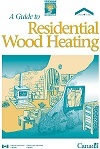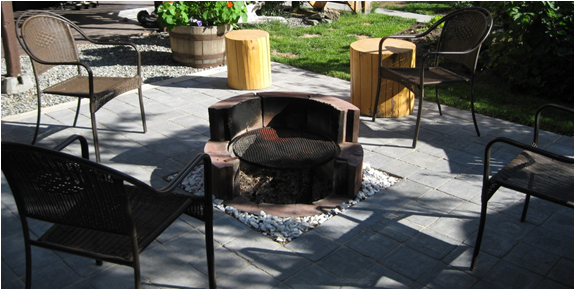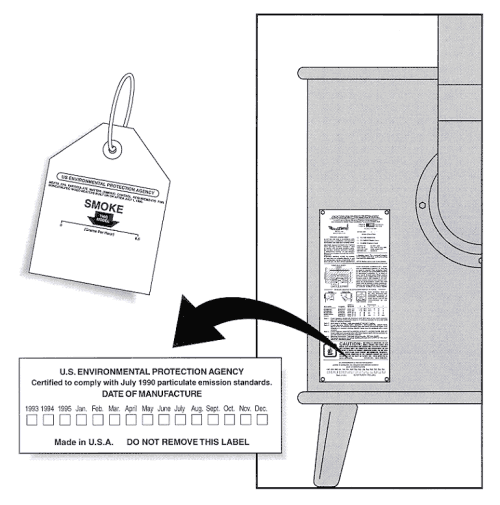Burning With Wood

 If you’re considering heating with wood, or already have a wood-burning appliance in your home, read NRCAN’s A Guide to Residential Wood Heatingthe informative website Woodheat.org.
If you’re considering heating with wood, or already have a wood-burning appliance in your home, read NRCAN’s A Guide to Residential Wood Heatingthe informative website Woodheat.org.
Solid fuel burning appliances installed within the City of Whitehorse must meet the CSA standard for solid fuel burning appliances or the U.S. standard. Click for guidelines on the installation and use of stoves, ranges, and space heaters that burn solid fuel. A building permit is required to install or replace a stove in your house.
- Remove cold ashes frequently. This maintains air circulation around the wood which increases hot burn.
- Ashes removed from a wood burning appliance should be placed directly into a metal receptacle with a tight fitting lid. This receptacle should then be placed out of doors onto a non-combustive surface (concrete or gravel) well away from any combustibles. After a minimum of one week, cold ashes can be bagged and added to your black cart, or saved for your garden.
- Reduce risk of chimney fire by brushing your chimney regularly to clean out creosote.
- Consult a certified WETT technician to inspect and clean your chimney to remove creosote build-up, check dampers and pipe for deterioration or corrosion.
Carbon monoxide (CO) is a colourless, odourless gas that is created through burning. If your stove or chimney is not operating properly, carbon monoxide can leak into your home and can be fatal.
Refer to the Yukon government’s website on carbon monoxide for more information.
View the City’s brochure on wood smoke.
Wood smoke can affect human health. Proper burning practices can reduce health risks.
- Wood smoke contains small particles that can cause coughing, headaches and irritation to the throat. Children, elders and people with heart conditions are most susceptible to wood smoke pollutants.
- Some contaminants from burning clean-dry wood can affect your health:
- Small particles can lead to serious respiratory issues.
- Carbon monoxide can cause fatigue, headaches, and nausea and can lead to death.
- Formaldehyde triggers asthma, coughing.
- Hydrocarbons can cause damage to lungs.
- Acrolein can cause eye & respiratory irritation.
- Click here for more information on the health effects of wood smoke.
- Wood smoke should be white or invisible. Grey or black smoke means there is a problem with your fuel, burning practices, stove or chimney.
- Never burn glossy paper (magazines, photographs), white office paper, cardboard, plastic, Styrofoam, or aluminum. These produce very toxic smoke, and can damage your stove’s expensive catalytic converter.
The Government of Yukon, in partnership with the City of Whitehorse and the Office of the Chief Medical Officer of Health, organizes public engagement sessions throughout Whitehorse to increase awareness and seek feedback and innovative recommendations from community members.
View the Government of Yukon’s What we heard document on Wood smoke in Whitehorse neighbourhoods.
- Only burn dry, seasoned fire wood
- Start fire only with newspaper and kindling
- Wood should be seasoned for 3-12 months (to reach 15% moisture content).
- Dry wood burns more efficiently. Burning green wood is inefficient, leads to incomplete combustion, excessive smoke and creosote build-up.
- Split your wood to expose more surface area and improve drying.
- Stack wood to allow good air circulation.
- Cover your wood to keep it dry.
- It is illegal to burn:
- waste (paper, plastic, cardboard, magazines)
- composite wood (plywood, particle board)
- painted or treated wood
- For quantities larger than 1 cord in Wolf Creek / Mary Lake / Sewage Lagoon / Haeckel Hill / Copper Haul Road, please obtain approval directly from Yukon Forestry (Mile 918.07 Alaska Hwy). Apply online at https://emr.eservices.gov.yk.ca/pubEMR/PUFWSignin.aspx
- For small quantities (less than 1 cord) within City limits that are blown down trees only, please obtain approval from Parks and Community Development using this online form or this PDF form, prior to obtaining a permit from Yukon Forestry (Mile 918.07 Alaska Hwy).
A burning permit is required for all open burning. Open burning permits can typically be obtained from October 1 to March 31, Monday to Friday, 8:30 a.m. to 4:30 p.m. at the Public Services Building.
To obtain an open burning permit, please send the following information to [email protected]:
- Pictures of the pile(s) you intend to burn;
- A description of material you intend to burn;
- A location of the burn site utilizing What3words (https://what3words.com); and
- Contact information for the person conducting the burning.
Residents can expect a follow-up within two business days during normal business hours.
There is no site inspection required. Please note: snow should be on the ground, and permit holders must maintain compliance with the instructions on the burning permit and/or those specified by the responding department member.
Burning must not occur until permission is granted by Fire Prevention staff.
Residents are required to provide payment before a permit can be issued; payments can be made to Bylaw Services.
Permit types are as follows:
- Open burning for land clearing purposes is $110/daily;
- Open burning for purposes other than land clearing is $22. A seven-day permit from the time of issue; and
- Open burning for purposes other than land clearing is $110. A seasonal permit that expires March 31, 2022, or revoked by the City of Whitehorse Fire Chief.
Remember you are responsible for the conditions outlined on the permit and under the ESB. If you choose to go beyond these restrictions, you may be held financially responsible for the response of emergency services.
Backyard Fire Pits

Backyard Fire Pit permits are issued by Whitehorse Fire and Protective Services.
Click here for information about backyard fire pits.
New Stoves
The basics
- Wood stoves installed in Whitehorse must be EPA Certified. EPA stoves reduce wood consumption by 20-25% and emissions by up to 90%.
- Pellet stoves require ULC certification.
Choose the right size
Get advice from an energy advisor to select a stove that is sized for your heating needs
A big stove may produce too much heat, forcing you to damp-it down (smolder), especially in milder weather
Smoldering fires are less efficient and produce more smoke, and lead to higher creosote build-up, which increases the risk of chimney fires
Good Energy rebates for stoves
The Government of Yukon provides Good Energy rebates for renewable heating systems that are more energy efficient, including certified wood stoves. For information on how to apply for the rebate, visit the Good Energy website.
A permit is required to replace an existing or install a new wood burning appliance. Our building inspections team reviews, issues and inspects all installations.
- You need to provide certain information when applying for a wood or pellet stove permit.
- For set-back requirements and chimney options refer to the Guidelines for the installation and use of stoves.
Wood stove certifications
All wood stoves installed in Whitehorse need to meet Environmental Protection Agency & CSA (ULC or Warnock Hersey) approval. Pellet stoves only require ULC safety certification. This has been a requirement since 1999 in Whitehorse, but is a new requirement for the rest of Yukon, resulting from changes to the 2010 National Building Code.
To determine if your wood stove meets these requirements, look for the wood stove certification sticker (usually found on the back of the stove).

You must notify your insurance company that you have installed a wood stove. Failure to do so could invalidate your insurance claim if you have a fire. Your insurance rates may change.
Carbon monoxide monitor
Carbon monoxide (CO) is a colourless, odorless gas that is a product of combustion. If your stove or chimney is not operating properly, CO can leak into your home and can be fatal.
A carbon monoxide monitor is required by law on every floor of your home where a wood or fuel burning appliance is located, as well as on every floor where there are bedrooms.
Carbon monoxide monitors are stand-alone units (battery or plug-in) or can be integrated with smoke alarms. A variety of CO monitors are available at hardware, big box, and building supply stores.
CO monitors need to be replaced regularly according to manufacturers’ instructions. Many CO monitors beep when they need servicing (e.g. low battery) or when they need replacement (approximately every 5 years).
To dispose of CO monitors properly:
- Remove and recycle all batteries
- Remove all plastic parts for recycling
- Dispose of the remainder of your CO monitor with “landfill” waste (i.e. black cart if you have curbside collection)
Refer to the Yukon government’s website on carbon monoxide for more information.
